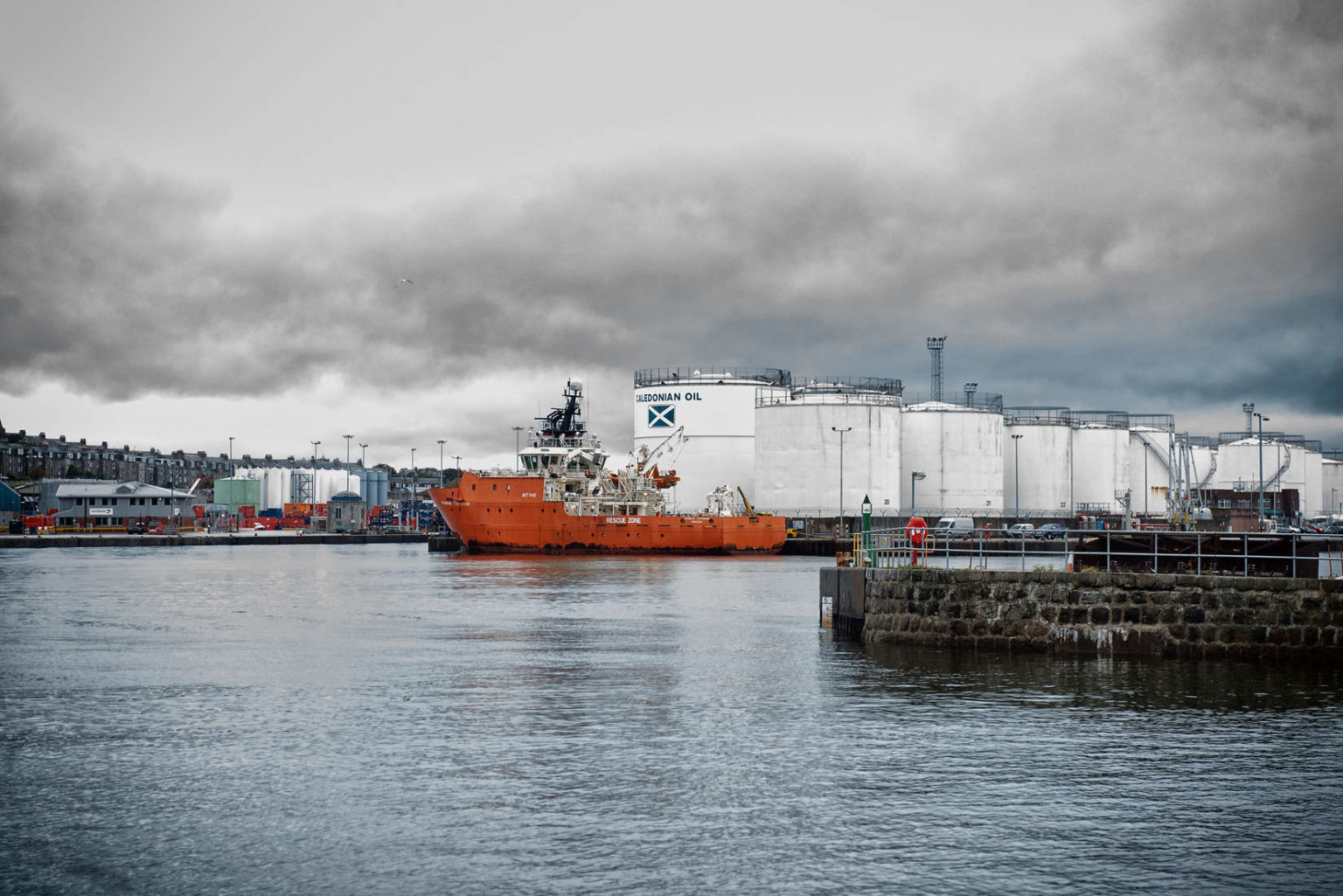Few vistas in the country offer such an impressive picture of industriousness as that of Aberdeen Harbour. Tall, brightly coloured prows of vessels servicing the oil industry jostle for space up against dockside installations and the terraced granite and concrete of the city centre.
For those looking for answers as to how the Scottish economy can move away, as it must, from hydrocarbons, the harbour seems to offer hope for a just transition. The jobs and trades of tomorrow are jumbled up with the older hydrocarbon sector as it gradually reaches the end of its productive lifespan.
There are only a handful of sites left in Scotland where heavy industry can still be observed up close in this way: Aberdeen’s lifeblood is centred around its harbour, constantly abuzz with the noise of loading sirens and the hum of diesel engines. It’s been this way for decades now.
Most of this work will have some kind of connection to the hundreds of oil and gas fields scattered across the North Sea — their names now often famous, Brent, Forties, Ninnian — yet part of a geography obscure and alien to most of the population.
That strangeness is fitting for a sector that prides itself on extracting oil in what are widely regarded as the most challenging conditions on the planet. This is not an industry that a layperson can simply observe and gain a clear understanding of. The oil itself moves quietly through pipelines and in tankers far out at sea. Much is hidden from view.
The towering vessels in Aberdeen harbour are built to perform myriad specialist tasks – decommissioning oil platforms at the end of their life, laying sub-sea cables, servicing and maintaining vast and immaculate outposts of fossil capital hundreds of miles from civilisation. Some now also visit renewables sites clearly visible from the coast, such as Vattenfall’s European Offshore Wind Deployment Centre, where the most powerful offshore wind turbines in the world operate.
Behind the scenes however, nothing is smooth or simple. Since the 2014 oil price downturn sent the price of Brent Crude plummeting from $115 per barrel in June 2014 to under $35 at the end of February 2016, the industry has been in what it refers to as a ‘recovery’ phase.
However, as prices have recovered from this low base, and as the industry has restructured around smaller private-equity backed firms, there has been a noticeable uptick in offshore activity.
But looked at in the context of just transition — the agreement that major trade unions have backed in a bid to make the shift from hydrocarbons benefit workers — the good times are already fading fast in what has always been a volatile sector. Industrial relations offshore are more fraught that they have been for decades.

Jake Molloy of the RMT
Cheap Labour
A particular sore point for the unions relates to what goes on aboard those ships plying their way in and out of Aberdeen harbour.
“All the work that’s getting done on renewables, and in decommissioning, is being done by vessels which carry Filipino, Malaysian crews, exploited on slave labour rates,” says Jake Molloy, the Aberdeen based Regional Organiser for National Union of Rail, Maritime and Transport Workers (RMT).
“The North Sea has become a dumping ground, literally a dumping ground, for workers to be exploited on appalling rates, in appalling conditions….” he adds.
Last year, this quiet controversy over the use of foreign-flagged vessels, some with crews on as little as £2.70 an hour, was brought dramatically to the fore. In a debacle that lasted for over a year, the 12-man crew of the Malaviya Seven was left stranded without pay in Aberdeen Harbour, after its Indian owner GOL went into liquidation.
The vessel had been chartered by BP and had previously been hired by other big oil companies such as Dana Oil, the Wood Group and Premier Oil.
The use of foreign registered ships with “flags of convenience” in the North Sea — upon which the national minimum wage is not currently enforceable — has also exacerbated a decline in the UK’s seafaring workforce, as pay and conditions have plummeted below those available onshore.
This is the raw reality of the UK’s deregulated maritime sector. Energy multinationals, bruised by the downturn, face no compulsion to address such practices. Their logic? If the installations don’t lie in regions with cheap labour, the cheap labour must come to the installations.
This picture is all the more troubling for trade unions, who hope decommissioning can play a role in mitigating job loses in the sector as platforms shut down. Over the next three decades more than 475 platforms, 10,000km of pipelines and 5,000 wells are expected to be removed from the North Sea.
An industry within an industry, decommissioning could be worth as much as £58bn on current terms. 50 to 75 percent of costs will be paid to companies by the UK government in tax relief.
If the undercutting of UK based seafarers makes Jake Molloy at the RMT angry, the prospect of major decommissioning work being “offshored” in a whole new sense, is particularly infuriating for his members, especially on platforms that have had a long lifespan.
Molloy cites work underway in the Greater Dunlin Area, being carried out by Fairfield Energy and the Brae Bravo platform, operated by Marathon Oil, as examples of how, far from decommissioning being used to protect and sustain the North Sea workforce, the opposite has been taking place.
“There’s some lads on these installations have been there their entire working lives. Now they’re being told that … the curtain will fall on them and they’ll be put off. And all the decommissioning work, which they’re more than able to do, and see the whole thing from cradle to grave, as it were, will be handed over to an outfit from Singapore.”
“I think morally and ethically that is fundamentally wrong and is a betrayal of the workers involved in those installations. It’s criminal,” he adds.
In response, two of the bigger players in offshore wind, Vattenfall and SSE, emphasise ethical supply chain codes of conduct, and their aim to build a 27,000 strong UK workforce as an industry by 2030. Neither company specifically ruled out the chartering of flags of convenience vessels.
Trickle Down
The picture onshore is undoubtedly more nuanced. Aberdeen and Grampian Chamber of Commerce are keen to assuage perceptions that the city and region will decline with oil. They cite £1.7bn in recently completed investment projects, and strong diversification efforts post-crash.
The economic shock of 2014 has caused Aberdeen to up its game. In some respects, it has the danger and the depths of the North Sea to thank for this. 40 years as the hub for extracting hydrocarbons from hard to reach wells has buttressed a reputation for excellence, innovation and a raft of specialist expertise. In areas such as diving for example, Aberdeen is second to none.
In the UK, unlike in Norway, the oil and gas industry was created in the image of the multinational private sector — it grew alongside the deregulation of finance capital, and this has shaped Aberdeen’s own fabric in turn.
It’s unsurprising then that public investment in infrastructure and housing lagged behind the economic growth during the city’s early boom years. From 1982, the influx of wealth meant that the city was no longer able to apply for regional development aid and for most of the decades of rapid expansion in the North Sea road and rail links south were not upgraded.
Unlike Shetland, where the local council managed to clinch a crucial deal to impose a levy on every barrel of oil transferred through Sullom Voe Oil Terminal, any direct revenues that did accrue to Aberdeen trickled down from central government.
Housing in particular has long been a controversial issue. A large amount of the riches accrued came in the form of windfall gains for homeowners — in 1983 the price of a three bed semi-detached house stood at 64 percent above the British average. The housing shortage was embedded during this period by restrictions preventing local government from expanding social housing.
On the far side of the boom time, the picture is often bleak. In October 2018, homeless charity Shelter Scotland went public to specifically highlight the struggles of former oil and gas workers to meet housing costs.
Few individuals have such an intimate understanding of these difficulties as the Reverend Gordon Craig, a Church of Scotland Minister who occupies the unique role of Chaplin to the UK Oil and Gas Industry.
“Undoubtedly house prices were well above what they should have been, but the result of that has been we’ve seen people who can’t leave because they’re in negative equity,” he explains.
“They’re out of a job, because their job was linked to the oil and gas industry, but they’re stuck, they can’t go anywhere, they can’t leave the house.”
Much of Craig’s work relates to administering a benevolent fund for offshore workers, open to families who are struggling to make ends meet.
“On virtually every platform I visit, there is somebody who knows someone who’s been off work for a while. Or who has a member of their family who’s been off work for a while, which is causing financial difficulties,” he explains.
Assumptions about the great wealth to be had in the oil industry have become a cultural reference point in Scotland. With an offshore workforce drawn from all over the UK, but particularly areas that witnessed de-industrialisation, such as the north east of England and the west coast of Scotland, work in the sector is synonymous with good earnings from a tough way of life.
However, the present reality is far more complex. Today, a typical offshore platform will have a small cadre of salaried workers directly employed by the owners, with the majority of workers contractors in a range of ancillary roles.
Offshore pay is still better than rates available on shore, but the hours are longer, the conditions inherently more stressful, and zero hours contracts have become increasingly commonplace. As Craig explains:
“…a great deal of them are folk who are only visiting that rig for two weeks at a time, and they’re not on any kind of shift schedule, they’re only called out when they’re required and if they’re not working they’re not paid.”
 `
`
Reverend Gordon Craig
Industrial Action
With the oil price back up at around $80 a barrel, a rally of over 40 percent over the past year, debate is raging between workers and companies over just how long the sector’s recovery phase will be maintained.
This tension recently came to a head in a major industrial dispute over the replacement of traditional two weeks on/three weeks off shift patterns, with a new three weeks on/three weeks off regime.
The Reverend Craig explains the disruption the new shift pattern caused for workers:
“People would say things to me like…the two/three lifestyle was fine for me, I’ve built my family life up around that, I can look after my mother who’s got Alzheimer’s, or I can look after the grandchildren or the children or whatever.
“When it suddenly went to three and three what we found … these kind of things were far more difficult to do. It was causing strain within the family,” he explains.
This has led to industrial action on a scale not seen since the aftermath of the Piper Alpha disaster in 1988, which claimed the lives of 167 offshore workers. Following strikes on Total owned platforms earlier this year, at the time of writing thousands of offshore contractors represented by Unite and GMB have voted for further action.
Such difficulties within the industry point to anxieties that, far from the managed just transition called for by environmental groups and trade unions, the North Sea workforce may simply diminish of its own accord, as the sector attempts to reduce pay and increase efficiencies.
Although delivering major subsidies to keep big oil operating in its territory, the UK government’s new Oil and Gas Authority, set up in 2015, was tasked with ‘maximising economic recovery,’ but there is precious little consensus between the representatives of labour and capital as to what that phrase will actually mean in practice.
While certain companies have reversed their implementation of the controversial new shift pattern, union leader Jake Molloy is pessimistic about the current state of the sector that he first joined in 1980:
“I think that’s got a lot of workers looking at it saying, ‘naw’. And this whole three week working on production platforms, I think that’s been the biggest backwards step we’ve seen.”
“There’s more and more workers walking away. We’re losing a generation. The whole skills base there.”
“Many workers now are at an age, my age, where three weeks going up and down stairs 12 hours a day, in pretty physically demanding hostile environments, is killing them. It’s killing them and they’re saying, ‘this is not worth it anymore’.”
Poverty
I meet Councillor Phillip Bell in the Scots-Baronnial splendour of Aberdeen’s Town House, the city’s historic seat of government constructed in a proud regional capital whose prosperity derived from industries that are all long gone: fishing, paper, shipbuilding.
Bell is a member of the Independent – Conservative and Unionist coalition that has controlled the city since the 2017 Scottish council elections.
The Councillor, who worked for BP for over thirty years, believes that the city’s future lies in bounty to be had from another easily transportable fuel — hydrogen.
“The oil and gas industry is very good at transporting gasses for instance, it’s very good at doing high-tech things, whether it be sub-sea, whether it be anything really.”
“All this skills base is thinking, what do I do now? I live in Aberdeen, it’s a great place to live, great quality of life, I want to stay here, so this is a wonderful opportunity for us all,” he says.
Put together in the wake of the downturn, the city has a multi-million pound hydrogen strategy — including a soon to be expanded fleet of buses and other vehicles.
It has also invested in state of the art refuelling facilities pioneering the technique of electrolysis, a key process required for hydrogen production from renewables to make a breakthrough.
The city will also seek to make a dent in its housing crisis with a programme of 2,000 social houses in its latest budget. A portion of these new homes will be served by a hydrogen network.
The private sector, under the leadership of celebrated Aberdonian entrepreneur Sir Ian Wood, has also offered a wider response to the downturn in the form of Opportunity North East, which, in addition to considering opportunities in energy is looking at diversification of the local economy in other high-tech emerging fields such as biotherepuetics.
But if this vision of renewed prosperity has galvanised cross-party support on the council, the underlying issue of who gets to share this new wealth is not going to disappear as the city transitions.
In October 2018, the newspaper that has served Aberdeen for centuries, the Press and Journal, carried a front page headline: “Shock figures show reliance on foodbanks”.
Poverty in the city has moved higher up the agenda — “oil rich Aberdeen” now has more foodbanks than any other Scottish city a d there is a 17 year gap in life expectancy between the most deprived and most affluent communities in the city.
Keen to point out that foodbank use is “not his area of expertise,” Councillor Bell recounts an anecdote about buying a homeless woman a sandwich, a hot drink and a cake:
“I didn’t feel particularly good about that. Because I did wonder, did she need to be out there begging, what was going on? And that’s a question I have to this day,” he recalls.
He doesn’t elaborate further on how this question relates to food bank use, stating:
“I just wonder, it’s terrible to feel you have to go to the food bank. But I don’t know who uses food banks and I don’t know why they use food banks. I was just telling you my experiences, I don’t have expertise in this field at all. These were just my experiences.”
The latest Figures from the Trussel Trust reveal that the largest group of food bank users are referred due to low income, with only 5 percent referred due to homelessness.
For many, work in Aberdeen — Scotland’s city of oil — is simply not paying enough to make ends meet.
All images by Alan McCredie
Subscribe to our newsletter
Stay up to date with DeSmog news and alerts









